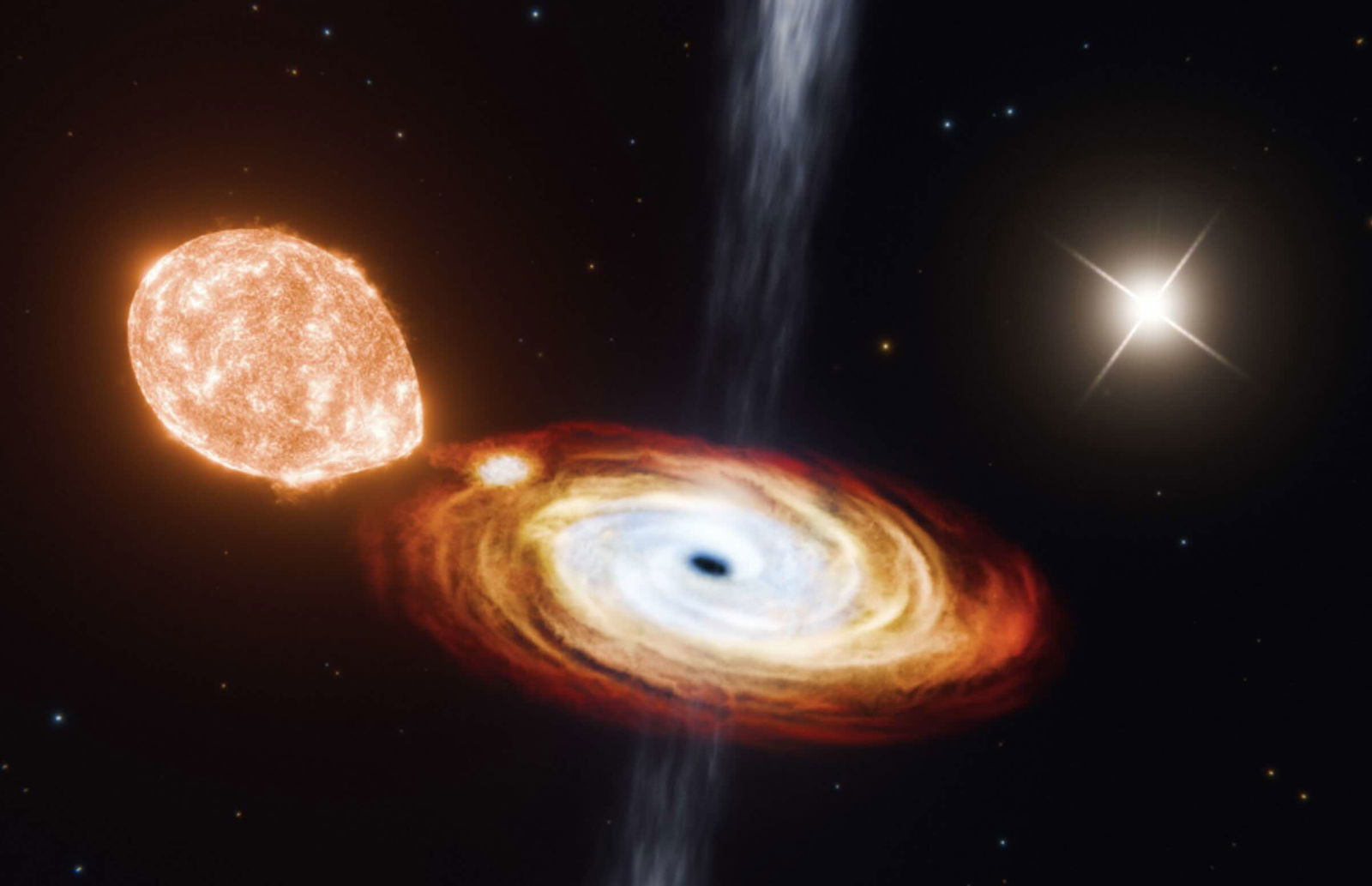A team of physicists from the Massachusetts Institute of Technology (MIT) and the California Institute of Technology (Cal Tech) say they’ve found evidence of something astronomers have never seen before: a ‘black hole triple.’
Many previously discovered black holes have another object in their orbit that may include a star, or even another black hole. However, the researchers say this is the first known example of a black hole with two stars trapped by its gravitational pull.
One of the stars orbits the black hole roughly every 6.5 days. This close distance means the black hole is slowly consuming the trapped star. The second star is much farther away, with astronomers estimating it orbits its host black hole every 70,000 years.
While finding stars close to black holes is common, discovering a star that is this distant from its host yet still within its gravitational influence is unusual. In fact, the researchers say that black hole formation methods usually favor a host star going supernova before it collapses into a black hole, a violent process that should kick any object this far away out of its gravitational reach.
Although some black hole formation models show the possibility of a star simply collapsing into itself without the explosion, a process astronomers call a “direct collapse,” this would be the first evidence of a black hole that was born in this fashion.
“We think most black holes form from violent explosions of stars, but this discovery helps call that into question,” explained study author Kevin Burdge, a Pappalardo Fellow in the MIT Department of Physics.
First Ever Black Hole Triple Discovered By Accident
Burdge and colleagues say their discovery of the first-ever black hole triple happened mostly by chance, while they were looking for newly formed black holes using an online tool called Aladin Lite. Comprised of data and imagery from an array of space and ground observatories, Aladin Lite allows researchers to look at particular regions of space from several different angles and light wavelengths.
While using the database, Burdge says he looked at a previously discovered black hole named V404 Cygni. First spotted in 1992, this particular black hole has been studied for decades, resulting in over 1,300 scientific papers.
None of those previous efforts noticed that V404 Cygni was a previously theoretical black hole triple.
After scanning optical images of the black hole, Burdge says he spotted observed two distinct regions of light. The first had been previously characterized as the back hole and the nearby star it was in the process of consuming. However, a quick scan of previous literature showed that the second, distinct blob of light was new. Given that it was visible on its own, the researcher quickly determined it was likely a distant star somehow caught in the black hole’s gravitational well.
“The fact that we can see two separate stars over this much distance actually means that the stars have to be really very far apart,” he explained.
Some quick calculations revealed that if it was another star, it was approximately 3,500 astronomical units (AU) from V404Cygni. One astronomical unit represents the distance between Earth and the Sun, meaning the newly discovered star was far from its host. The distance was large enough that Burdge wondered if the black hole’s gravity was indeed holding it.
To answer that question, Burdge and colleagues turned to Gaia. A space-based observatory, Gaia has tracked the motions of stars in the Milky Way galaxy since 2015.
Sure enough, the Gaia data showed that the close star and the far-out star were moving in tandem. Although it was possible without the outer star succumbing to the black hole’s gravitational pull, the researchers determined that the chances of that were roughly one in ten million.
“It’s almost certainly not a coincidence or accident,” Burdge says. “We’re seeing two stars that are following each other because they’re attached by this weak string of gravity. So this has to be a triple system.”
Direct Collapse Theory Reveals Black Hole’s Age
In the study’s conclusion, the researchers note that the violent explosion of a star going supernova should push a star this distant from the event even farther away.
“Imagine you’re pulling a kite, and instead of a strong string, you’re pulling with a spider web,” Burdge says. “If you tugged too hard, the web would break, and you’d lose the kite. Gravity is like this barely bound string that’s really weak, and if you do anything dramatic to the inner binary, you’re going to lose the outer star.”
This analysis was confirmed by several black hole formations, nearly all of which showed the supernova explosion pushing the star out of the resultant black hole’s gravitational reach. While inconclusive, this likely supports the idea that V404 Cygni is the first known example of a black hole formed via direct collapse.
“The vast majority of simulations show that the easiest way to make this triple work is through direct collapse,” Burdge says.
Another unexpected benefit of the team’s discovery of a black hole triple was the ability to give the system an appropriate age. According to the study authors, the newly discovered star is in the process of becoming a red giant. Since this occurs at the end of a star’s life, they were able to pinpoint its age, something that had previously been impossible.
“We’ve never been able to do this before for an old black hole,” Burdge says. “Now we know V404 Cygni is part of a triple; it could have formed from direct collapse, and it formed about 4 billion years ago, thanks to this discovery.”
“This system is super exciting for black hole evolution,” he added, “and it also raises questions of whether there are more triples out there.”
The study “The black hole low-mass X-ray binary V404 Cygni is part of a wide triple” was published in Nature.
Christopher Plain is a Science Fiction and Fantasy novelist and Head Science Writer at The Debrief. Follow and connect with him on X, learn about his books at plainfiction.com, or email him directly at christopher@thedebrief.org.

